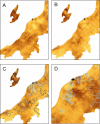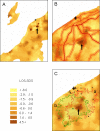Referral from secondary care and to aftercare in a tertiary care university hospital in Japan
- PMID: 16503979
- PMCID: PMC1388212
- DOI: 10.1186/1472-6963-6-11
Referral from secondary care and to aftercare in a tertiary care university hospital in Japan
Abstract
Background: In Japan, all citizens are covered by the national insurance system in which universal free access to healthcare services is promised to everybody. There are no general physicians or gatekeepers in the Japanese healthcare system.
Methods: We studied the pattern of referral of inpatients from secondary care hospitals to a tertiary care university hospital and the reverse referral under the situations using a geographic information system (GIS), taking paediatric inpatients as an example.
Results: The results showed that 61.2% of the patients were directly admitted to the hospital without referral from other hospitals or clinics and that 82.8% of the inpatients were referred to the outpatient department of the hospital to which they had been admitted. GIS analysis for the inpatients service area showed the hospital functions as both a secondary care hospital and tertiary care hospital. Patients who lived near the hospital tended to be admitted directly to the hospital, and patients who lived far from the hospital tended to utilize the hospital as a tertiary care provider. There were territorial disputes with other secondary care hospitals. To estimate spatial differences in referral to aftercare, we analyzed the spatial distribution of inpatients with focus on their length of hospital stay (LOS). GIS analysis revealed apparent foci of patients with long LOS and those with low LOS.
Conclusion: These results suggest that the function of university hospital in Japan is unspecialized and that the referral route from the university hospital to aftercare is also unequipped.
Figures





Similar articles
-
Non-specialized inpatient care provided by university hospitals in Japan.Risk Manag Healthc Policy. 2008;1:23-9. doi: 10.2147/RMHP.S4155. Epub 2008 Nov 18. Risk Manag Healthc Policy. 2008. PMID: 22312200 Free PMC article.
-
Length of stay, referral to aftercare, and rehospitalization among psychiatric inpatients.Psychiatr Serv. 2003 Sep;54(9):1271-6. doi: 10.1176/appi.ps.54.9.1271. Psychiatr Serv. 2003. PMID: 12954945
-
[Geographic pattern of hospital selection among cancer inpatients in Japan: A focus on secondary healthcare service areas and designated regional cancer hospitals].Nihon Koshu Eisei Zasshi. 2015;62(12):719-28. doi: 10.11236/jph.62.12_719. Nihon Koshu Eisei Zasshi. 2015. PMID: 26781622 Japanese.
-
Appendix to dialysis centre guidelines: recommendations for the relationship between outpatient haemodialysis centres and reference hospitals. Opinions from the Outpatient Dialysis Group. Grupo de Trabajo de Hemodiálisis Extrahospitalaria.Nefrologia. 2011;31(6):664-9. doi: 10.3265/Nefrologia.pre2011.Oct.11001. Nefrologia. 2011. PMID: 22130281 English, Spanish.
-
Analyzing hospital admission rates at the community level.J Nurs Care Qual. 1999 Nov;Spec No:25-39. doi: 10.1097/00001786-199911000-00005. J Nurs Care Qual. 1999. PMID: 10616273 Review.
Cited by
-
A Cohort Study of the Relationship between Active Collaboration and Operational Efficiency in Japanese Public Health Institutions.JMA J. 2022 Oct 17;5(4):438-445. doi: 10.31662/jmaj.2021-0195. Epub 2022 Aug 1. JMA J. 2022. PMID: 36407060 Free PMC article.
-
Non-specialized inpatient care provided by university hospitals in Japan.Risk Manag Healthc Policy. 2008;1:23-9. doi: 10.2147/RMHP.S4155. Epub 2008 Nov 18. Risk Manag Healthc Policy. 2008. PMID: 22312200 Free PMC article.
-
Status of epilepsy care delivery and referral in clinics, hospitals, and epilepsy centers in Japan: A nationwide survey.Epilepsia Open. 2024 Feb;9(1):314-324. doi: 10.1002/epi4.12874. Epub 2023 Dec 9. Epilepsia Open. 2024. PMID: 38044839 Free PMC article.
-
Trend in geographic distribution of physicians in Japan.Int J Equity Health. 2009 Mar 3;8:5. doi: 10.1186/1475-9276-8-5. Int J Equity Health. 2009. PMID: 19257879 Free PMC article.
-
Effectiveness of a virtual reality-based sensory stimulation intervention in preventing delirium in intensive care units: a randomised-controlled trial protocol.BMJ Open. 2025 Jan 15;15(1):e083966. doi: 10.1136/bmjopen-2024-083966. BMJ Open. 2025. PMID: 39819916 Free PMC article.
References
-
- Organization for Economic Co-operation and Development (OECD) Health data. Paris: OECD; 2003.
MeSH terms
LinkOut - more resources
Full Text Sources
Medical

